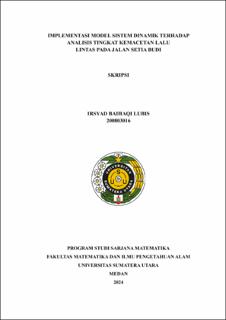| dc.contributor.advisor | Syahputra, Muhammad Romi | |
| dc.contributor.author | Lubis, Irsyad Baihaqi | |
| dc.date.accessioned | 2025-01-24T03:34:57Z | |
| dc.date.available | 2025-01-24T03:34:57Z | |
| dc.date.issued | 2024 | |
| dc.identifier.uri | https://repositori.usu.ac.id/handle/123456789/100579 | |
| dc.description.abstract | Overcoming existing traffic congestion is something that many people hope for, especially people who are still always trapped in these traffic problems. One of the ways that can be used to reduce the level of traffic congestion is the dynamic system approach method. This method analyzes and simulates the problem by determining the causal variables. The analysis is conducted using a causal loop diagram model which is then simulated with a stock flow diagram model using Ventana Simulation (Vensim) software. The results showed that there was a decrease in the average level of traffic congestion on Jalan Setia Budi with an initial condition of 1.06% to 0.71%. This 32% decrease has an impact on traffic conditions that are busy without any delays in travel time on Jalan Setia Budi. | en_US |
| dc.language.iso | id | en_US |
| dc.publisher | Universitas Sumatera Utara | en_US |
| dc.subject | Causal loop diagram | en_US |
| dc.subject | Stock and flow diagram | en_US |
| dc.subject | Traffic congestion Simulation | en_US |
| dc.subject | Dynamic system | en_US |
| dc.title | Implementasi Model Sistem Dinamik terhadap Analisis Tingkat Kemacetan Lalu Lintas pada Jalan Setia Budi | en_US |
| dc.title.alternative | Implementation of a Dynamic System Model to Analyze the Level of Traffic Congestion on Setia Budi Street | en_US |
| dc.type | Thesis | en_US |
| dc.identifier.nim | NIM200803016 | |
| dc.identifier.nidn | NIDN0115118903 | |
| dc.identifier.kodeprodi | KODEPRODI44201#Matematika | |
| dc.description.pages | 98 Pages | en_US |
| dc.description.type | Skripsi Sarjana | en_US |
| dc.subject.sdgs | SDGs 9. Industry Innovation And Infrastructure | en_US |


